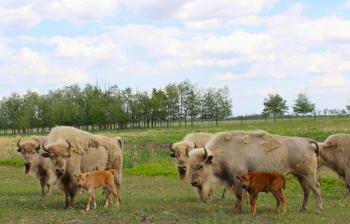Image Caption
Summary
Local Journalism Initiative Reporter
Windspeaker.com
Seven wood bison calves are now among the almost 60 bison roaming the grounds at Métis Crossing at Smoky Lake, north of Edmonton.
Those calves are both a recognition of the past and a promise for the future, says CEO Juanita Marois.
Métis Crossing, a cultural interpretive tourist destination, is located along the banks of the North Saskatchewan River on land once settled by Métis in the 1800s. While archaeological digs show that First Nations travelled through the area and traded, it was the Métis who built houses, planted gardens and raised crops there.
The area was also a transition zone for the plains bison from the south and the wood bison from the north.
“We always knew that buffalo had to be an important part of the story,” said Marois about Metis Crossing, who points out that 320 acres of land was set aside for that purpose when the facility was opened in 2005.
But that dream was reached sooner than expected through acts of reconciliation by both a local rancher and the nearby Elk Island National Park.
Just after the 11,000-square-foot cultural gathering centre was built at Métis Crossing in 2019, non-Indigenous rancher Len Hrehorets approached Marois about a plan that resulted in a 2021 joint venture.
Years earlier, one of Hrehorets’ children had been involved in a car accident. As he and his wife sat by their daughter’s bedside in the hospital, he conceived of a wildlife park that held majestic animals, such as bison, and could create hope and vision for his family. Later, he decided he wanted to share such a wildlife park with the public.
“He's a very good rancher, but he doesn't know the visitor economy or anything like that. When he saw Métis Crossing being built, he saw it as an opportunity. We really took the next year to build something together (and) now we have Visions, Hopes and Dreams at Métis Crossing Wildlife Park,” said Marois.
Then, in 2022, through Parks Canada’s reconciliation program, Elk Island park transferred 20 wood bison to Métis Crossing. While the bison were pregnant before the transfer happened, “it’s pretty amazing” to have the first calves born that belong to Métis Crossing, said Marois.
“We were very fortunate that seven of them were impregnated and very happily gave birth,” she said, despite the disruption of being moved.
Between the joint venture and the transfer, Visions, Hopes and Dreams at Métis Crossing Wildlife Park comprises five separate paddocks with 20 wood bison and the seven calves, 15 plains bison (13 cows and two bulls), a rare herd of 15 white bison (13 cows and two bulls), 25 white and regular-coloured elk (23 cows and two bulls), and 23 Percheron mares.
“As Métis people, the bison have been absolutely foundational to our growth as an Indigenous nation,” said Marois.
Along with being a food source, bison were also important to the economy and governance.
Pemmican, made of dried bison pounded into a course powder mixed with melted fat and berries, was stored inside bison stomach to be kept safe and unspoiled over the winter. It was sold to fur traders.
“(Buffalo) was the basis of our government system. We had our buffalo hunt and we would elect a buffalo council and we would appoint the captain of the buffalo hunt. And, I mean, that was life and death for our communities. Certainly, without the buffalo hunt, without a successful hunt, we wouldn't survive,” said Marois.
Now with the bison back and the herds anticipated to keep growing, Marois says Métis Crossing will become a “regenerative destination.”
When the bison were almost lost because of overhunting and when agriculture took over, the natural environment and the land base changed, she says.
With the bison roaming the land now, eating the prairie grass, seeds will be spread through their manure, Marois says, and that will work toward re-establishing the natural lands.
She also notes that the gathering centre will use the bison meat as their main source of protein.
“It will be a component of the food security within our nation, as well as the economic security as we begin to sell that to others,” she said.
For Métis people, the Crossing is an opportunity to connect with their roots and share their stories. Cultural camps are offered in partnership with the Métis Nation of Alberta for Métis families across the province.
“Many of us are now urban. We live in urban centres and we don't have that opportunity to connect to the land in the same way,” said Marois.
For non-Métis, the Crossing is an opportunity to experience a different culture and Marois urges visitors to stay for “not only two or three hours, but two or three days.”
There’s plenty of options for accommodations.
New this season are sky watching domes that allow visitors to sleep under the stars with all the amenities of a king-sized bed, kitchenette, bathroom and electricity.
A lodge, opened in May 2022, offers 40 rooms, with each bed covered by a handmade quilt.
There are 21 powered sites for recreational vehicles, as well as camping sites. Trappers’ tents can also be rented for the night.
Local Journalism Initiative Reporters are supported by a financial contribution made by the Government of Canada.

